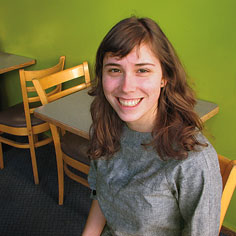
Deren Guler (S 2009)
Physics major, DJ, first author on paper in Chemistry and Physics of Lipids
Bio
Using x-rays to study the properties of lipid bilayers
When she's not taking photographs for The Tartan or DJing for Carnegie Mellon's radio station, Deren Guler might be in the lab conducting biophysics research or on her way to New York to pull all-nighters at the Cornell High Energy Synchrotron Source.
"The Cornell High Energy Synchrotron Source (CHESS) is a huge facility that not that many scientists get to go to. It was an incredible experience to be there, but it was intense," said Guler, a physics major. "Our team worked 12 hour shifts from 4:00 in the morning to 4:00 in the afternoon. They don't want to waste time while the beam is up."
Using the high-intensity beam of x-rays at CHESS, Guler and her advisor Research Professor Stephanie Tristram-Nagle studied the properties of lipid bilayers. They focused their studies on the lipid dihexadecyl-glycerol-phosphocholine (DHPC), which is present in bacterial cell membranes and in human adipose and brain tissue. Guler was interested in figuring out how changes in DHPC's structure affects permeability of the membrane to water.
The paper describing her research findings was published in the journal Chemistry and Physics of Lipids. Guler also presented her findings at the annual meeting of the Biophysical Society in Boston.
"At the conference there were people from all over the world, which was really cool. Scientists from Canada and Argentina came to my poster, and they were asking me questions about my work."
Guler was more than prepared to answer their questions. As soon as she walked into Tristram-Nagle's lab during her junior year, she became an integral part of the research team.
"They put me in immediately, asked me things, forced me to think about things," said Guler. "Instead of learning something out of a textbook and solving problems, I was trying to solve something that really doesn't have an answer."